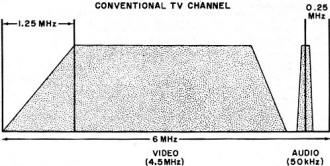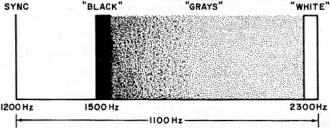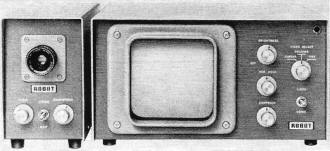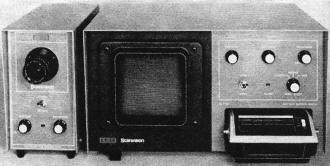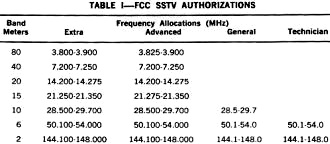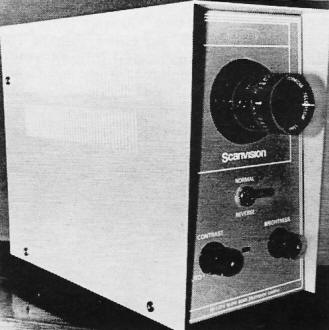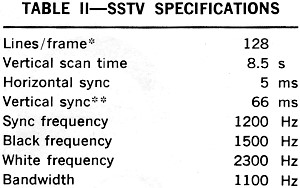The Challenge of Slow-Scan TV
|
|
You would be forgiven if you think a technology as crude as slow-scan television (SSTV) has gone out of vogue with live YouTube videos and webcams, but such is not the case. What has changed is the portion of Amateur Radio spectrum allocated to SSTV and which classes of license holders may use it. Of course the equipment used has been modernized, but vintage systems still work. Originally, only Advanced class ticket holders were allowed access, but nowadays all Hams may operate SSTV, including the entry level Technician class. SSTV was used extensively on space exploration platforms including Apollo; in fact the historic Apollo 11 video feed of astronauts Armstrong and Aldrin hopping around on the moon were transmitted via SSTV. ARISS (Amateur Radio on the International Space Station) regularly transmits via SSTV. The Challenge of Slow-Scan TV Amateur Radio - Coast-to-coast tests show how it works. By Richard Humphre
In this article we will be discussing some of the technical aspects of SSTV. We conducted some SSTV tests, the results of which, along with our observations, will be presented. Finally, non-ham applications of SSTV will be discussed, as will the possible role the ham will play in perfecting the system. Technical Data Narrow bandwidth is the key to slow-scan TV. As a comparison, commercial, or home-type, TV channels are each 6 MHz wide (see Fig. 1), while SSTV is a mere 1100 Hz wide. The 525-line, 30-frame/second commercial system used in the U.S. requires a video span of roughly 4.5 MHz, even with the suppression of one sideband, a 50-kHz audio bandwidth, and guard bands between the audio and video and at each end of the channel to prevent interference. By contrast, SSTV employs audio-frequency subcarriers for sync and black-and-white, 8-second/frame picture rate, and only 120-128 lines/frame (see Table II for more complete details). This results in a modulating frequency spread of 1100 Hz as shown in Fig. 2. Fig. 1 - The diagram shows the frequency ranges for signals on conventional TV. Fig. 2 - The modulating frequency spread for slow-scan TV is about 1100 Hz with black at 1500 Hz and shades of gray in steps up to the white signal at 2300 Hz.
Fig. 3 - An 8-second time exposure of an SSTV picture shows good linearity. The Robot Research, Inc., Model 80 SloScan camera is shown at left with the companion monitor and receiver Model 70 at right. The SBE Scanvision, made by Linear Systems, Inc., features a built-in cassette tape recorder and 25-mm C-mount camera lens. Table 1 - FCC SSTV Authorizations Note: SSB on all amateur frequencies; DSB (AM) on 6, 2, and up only. Novices have no SSTV rights. Simultaneous (SSTV on one sideband, voice on other sideband) transmission permitted on all listed amateur frequencies. SBE Scanvision camera with 25-mm lens is priced at around $500.
Table II - SSTV Specifications *Up to introduction of commercial equipment, was usually 120. **Up to introduction of commercial equipment, pulses were usually 30 ms. The width of the modulating frequency is dependent primarily on the number of lines per frame and the number of pictures per frame. By reducing both (via audio sync and black-and-white sub carriers), SSTV can he transmitted via SSB, it can be sent over conventional telephone lines without the need for special coaxial TV-quality cable, and it can be recorded on an audio tape recorder. With respect to the last, an inexpensive cassette recorder will do if the tape speed is constant. The trade-off in SSTV for not being held to line-of-sight transmission and all other extras is that only "still" pictures can be transmitted and extra-fine detail is not possible. An example of an SSTV picture is shown in Fig. 3. Going back to Fig. 2 for the moment, sync pulses are on a 1200-Hz subcarrier; "black" rides on a 1500-Hz carrier (this means the sync signal is blacker-than-black, thus blanking out the retrace as the beam returns to the left of the CRT), and "white" is transmitted at 2300 Hz. An SSTV signal, when heard on the air, sounds like a science-fiction movie soundtrack. A black-and-white line drawing or black letters on a white background ( or vice versa) yields an audio signal that alternates between 1500 Hz and 2300 Hz, while the 1200-Hz sync subcarrier remains constantly on. When pictures with various shades of gray are transmitted, black, white, and audio will vary in step with the shades of gray at intermediate steps between 1500 Hz and 2300 Hz. SSTV Tests Our tests of the SSTV system were conducted coast-to-coast between Watsonville, California and Governor's Island, New York. The hookup was a combination of landline (telephone) and microwave relay. The test was primarily intended to determine whether or not SSTV could be a workable tool in inland and maritime search and rescue work. Using Linear Systems' "Scanvision" equipment on both ends and Linear Systems' Manager of Amateur Factory Services, Stuart E. Till, in California and an officer class of the National Search & Rescue School (including representatives of West Germany, Denmark, Canada, the U.S. Air Force, and U.S. Coast Guard) on the East Coast, test patterns, typescript text, and pictures of live subjects were exchanged. Here is some of the feedback from those tests: Inevitably, there is an unconscious urge to compare SSTV picture quality with that of commercial broadcast pictures. However, one soon realizes that SSTV was never intended to provide commercial quality pictures, nor is such quality necessary. The 25-mm lens supplied with the camera provided the best picture quality. Subsequent tests with other lenses ranked a 35-mm unit high and a 180-mm one marginal. (This last lens was a "cheapie," so, we cannot fault SBE's gear for the poor reproduction. ) The best lighting setup for three-dimensional subjects was two 300-watt bulbs with reflectors set at 45° on either side of the camera. For two-dimensional subjects (QSL cards, numbers and letters, and the like), one 500-watt bulb in a reflector, positioned directly above the camera, yielded the best results. It might be argued that this is a lot of light with the camera between 2 and 3 feet from the subject, but it did let us stop the lens down to f/22, cut the camera brightness down, and come up with the best picture on the monitor. The Bell System's fantastic space-age service made it necessary to spend more than three hours getting a connection that was free enough of line noise, distortion, and with high enough audio level to transmit a suitable picture. This is not to say that SSTV is more critical of line quality than is the human ear; we could not hear each other over the same lines. We did determine that while line noise could wipe out the picture completely, low audio could be countered by simply cranking up the brightness and contrast on the monitor/receiver. Finding the proper connections inside the telephone is best done with headphones (when you hear a dial tone, you have it). It is important to monitor the signal level on both the telephone line and the radio transmission to prevent cross-modulation in the first case and "splatter" in the second. Whether a cassette recorder (such as SBE's built-in unit) or an open-reel recorder is used is academic. Tests with an outboard recorder operated at 3 3/4 and 7 1/2 ips revealed little, if any, improvement over the built-in 1 7/8 ips recorder with reference to picture quality. Good motor speed regulation with no "wow" is the key to recording slow-scan TV signals. Since SSTV operates at between 1200 and 2300 Hz, frequency response is relatively unimportant. Other Uses For SSTV Presently, the main user of SSTV is the radio amateur operator. The staff and class at the National Search & Rescue School came up with some non-ham applications. One was the transmission of search patterns to quasi-military groups not familiar with the international search and rescue terminology as taught by the SAR School. This could include the Civil Air Patrol which performs more than 7S percent of U.S. inland searches on a routine basis, as well as sheriff's offices and others. To a certain extent, it could include the U.S Coast Guard Auxiliary. Using SSTV to transmit schematic diagrams and other technical data to remote installations, such as Loran sites, to provide engineering aid to technicians was another suggestion. Uses by law enforcement agencies, banks, and other security organizations in need of quick transmission of identification were yet other possible applications for SSTV. In connection with search and rescue, we found that maps and nautical charts did not come through very well because of their lack of contrast and masses of small details. Typewritten text also suffered. The Ham's Role Slow-scan TV is at a stage where in-field operational experimentation is needed. This is one job at which the radio amateur is superlative. A body of literature on the use of different lenses (what about the feasibility of a three- or four-lens turret, for instance?) for different jobs is needed. The same applies to lighting arrangements. Too, the possibility of using the interlacing technique to obtain better picture detail - at a reasonable price, of course - can be investigated. A host of other questions must be answered, and the ham is in the best position to do the necessary investigation and experimentation. The fascination of sitting in a dark room looking at the face of the SSTV receiver's CRT cannot be denied. Whether it is worth from $600 to $1000 to do it, not to mention the skull-cracking to get your Extra or Advanced ticket, is up to you. Of course, if you do not mind putting together your own system from basic components, you can probably reduce the cost considerably.
Posted February 29, 2024 |
|

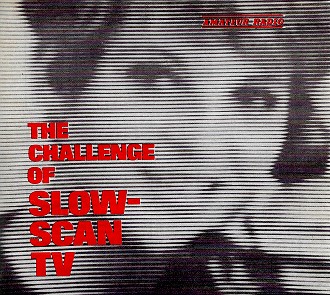 The arrival of slow-scan television (SSTV) to the amateur
radio bands is making incentive licensing a workable proposition for the first time since
its inception. Since SSTV can be used only on the portions of 80 through 15 meters set aside
for Extra and Advanced ticket holders (see Table I). books are being cracked and rusty fists
are practicing CW as General and Technician licensees bone up for the FCC exams to upgrade
their tickets.
The arrival of slow-scan television (SSTV) to the amateur
radio bands is making incentive licensing a workable proposition for the first time since
its inception. Since SSTV can be used only on the portions of 80 through 15 meters set aside
for Extra and Advanced ticket holders (see Table I). books are being cracked and rusty fists
are practicing CW as General and Technician licensees bone up for the FCC exams to upgrade
their tickets. 